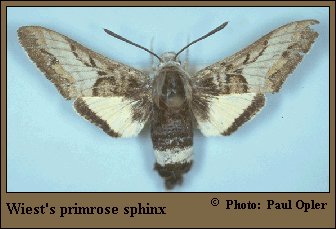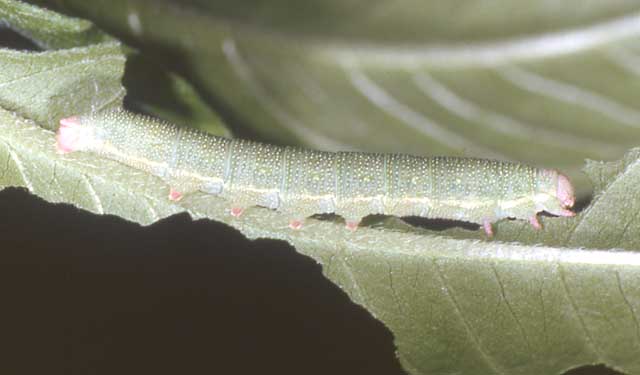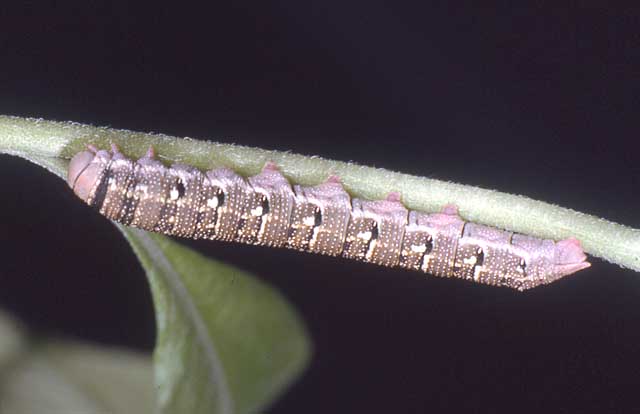Euproserpinus wiesti
|
|
Updated as per range indicated in James P. Tuttle's The Hawk Moths of North America, September 7, 2010
|
Euproserpinus wiesti
Speery, 1939
Prairie Sphinx or Wiest's Primrose Sphinx

Euproserpinus wiesti courtesy of Paul Opler.
This site has been created by
Bill Oehlke at oehlkew@islandtelecom.com
Comments, suggestions and/or additional information are welcomed by Bill.
TAXONOMY:
Family: Sphingidae, Latreille, 1802
Subfamily: Macroglossinae, Harris, 1839
Tribe: Macroglossini, Harris, 1839
Genus: Euproserpinus Grote & Robinson, 1865...........
Species: wiesti Speery, 1939
|
MIDI MUSIC
.....It's a Wonderful World.....
copyright C. Odenkirk
ON.OFF
<bgsound src="world.mid" LOOP=FOREVER>
|
DISTRIBUTION:
The extremely rare Prairie Sphinx or
Wiest's Primrose Sphinx, Euproserpinus wiesti,
[wingspan: 1 1/4 - 1 15/16 inches (3.2 - 4.9 cm)],
flies in northeast California through central Nevada and most of Utah to northeastern Arizona and
northern three-quarters of New Mexico and most of Colorado,
and further eastward into extreme western portions of Kansas, Oklahoma and Texas.
The body is black with a white band across the abdomen. The upperside of the forewing is gray-brown;
the median area has black lines and a gray band; the underside is white with a black outer margin. The upperside
of the hindwing is yellowish white with a narrow black outer margin and black at the base; the underside is white with
black at the base and a black marginal band.
FLIGHT TIMES:
Euproserpinus wiesti adults fly over sand washes and
prairie blow-outs as a single brood from May-June. Adults nectar at flowers during the warm parts
of the day.
ECLOSION:
Moths probably wiggle free from pupae in shallow subterranean chambers.
SCENTING AND MATING:
Females call in the males with a pheromone released from a gland at the tip of the
abdomen.
EGGS, LARVAE AND PUPAE:
Females deposit eggs singly at the base of host leaves. The eggs hatch in
7-10 days.
Larvae feed on prairie primrose (Oenothera latifolia) in the evening primrose family
(Onagraceae). Trying to rear in captivity has proven difficult. Larvae seem to need sunshine, heat and humidity.
Pupae probably should be stored in a humid environment (damp tissue wrap) if kept in an artificial situation.
Pupation is in shallow subterranean chambers
a couple of inches below soil surface.

Euproserpinus wiesti fourth instar, courtesy of James P. Tuttle.

Euproserpinus wiesti fifth instar, courtesy of James P. Tuttle.
Use your browser "Back" button to return to the previous page.
Goto Main Sphingidae Index
Goto Macroglossini Tribe
Goto Central American Indices
Goto Carribean Islands
Goto South American Indices
Goto U.S.A. tables


